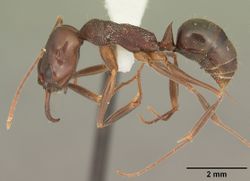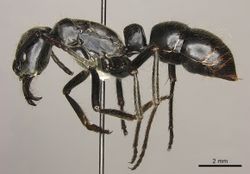Key to Neotropical Ponerinae genera
This key is translated and modified from Baccaro et al (2015)[1] with permission of the authors, adding the genus Belonopelta, complemented with Schmidt & Shattuck (2014)[2]
This key covers all the Neotropical Ponerinae except the genus Ponera. Only one species Ponera pennsylvanica has been reported from Mexico, and Ponera ruficornis cited from Brazil is incertae sedis in Ponera.
1
- Mandibles long and linear, inserted in the medial anterior portion of the head, semiparallel when closed and forming 180 degrees when open .....2
- Mandibles otherwise, inserted in the lateral anterior portion of the head, never semiparallel when closed and forming 180 degrees when open .....3
2
return to couplet 1
- Nuchal carinae "V" shaped converging in the middle of the posterior margin of the head. Apofisal lines present and well defined. Apex of the petiolar node generally conical or pointed ..... Odontomachus (Neotropical species ID)
- Nuchal carinae forming a continuous line through the posterior margin of the head. Apofisal lines absent. Petiolar node varying, subtriangular, squamiform or bidentate Anochetus (Neotropical species ID)
3
return to couplet 1
- Mandibles very long and slender, with three or four spiniform teeth, long and very sharp. ..... 3'
- Mandibles triangular or falcate, without teeth as described .....4
3'
return to couplet 3
- Antennal insertions separeted by a distance smaller than 1/3 of the head width. The apical tooth not touching the anterolateral region of the opposite side of the head when closed. Eyes very small, usually single faceted ..... Belonopelta (Neotropical species ID)
- Antennal insertions separeted by a distance smaller than 1/3 of the head width. The apical tooth touching the anterolateral region of the opposite side of the head when closed. Eyes well developed and conspicuous, with nummerous ommatidia ..... Thaumatomyrmex (Neotropical species ID)
4
return to couplet 3
- Giant ants. Head width >4.00 mm. Anterior clypeal margin with a pair of projecting teeth ..... Dinoponera (Neotropical species ID)
- Smaller ants. Head width <4.00 mm. Anterior clypeal margin without a pair of projecting teeth .....5
5
return to couplet 4
- Petiole subrectangular to subcylindrical with the posterior side concave ..... Platythyrea (Neotropical species ID)
- Petiole varying, but never as described above .....6
6
return to couplet 5
- Tarsal claws in anterior legs frequently finely pectinated, rarely with one or two preapical teeth. Clypeus sometimes with a medial carina and with its anterior face triangular and prominent. Mandibles slender and sharp, with its masticatory margin oblique and normally without conspicuous teeth ..... Leptogenys (Neotropical species ID)
- Tarsal claws in anterior legs single, or with a preapical tooth at most. Clypeus generally without a medial carina and with its anterior margin varying, but very rarely triangular or subtriangular. Mandibles usually triangular; if slender and sharp then with conspicuous apical and preapical teeth.....7
7
return to couplet 6
- Mandibles long, with its masticatory margin clearly oblique with 3 to 4 big teeth. Medial portion of clypeus widely triangular, and projected anteriorly. Eyes usually formed by a single ommatidium or absent. In profile view, the frontal lobes abruptly elevated over the cephalic plane ..... Simopelta (Neotropical species ID)
- Mandibles subtriangular, with numerous teeth or denticles in its masticatory margin. Medial portion of clypeus never triangular, and not projected anteriorly. Eyes variable in size .....8
8
return to couplet 7
- External surface of basitarsi with numerous spiniform quetae. Head wider than long, usually heart shaped. Eyes absent ..... Centromyrmex (Neotropical species ID)
- External surface of basitarsi without spiniform quetae. Head usually slightly longer than wide. Eyes varying, rarely absent .....9
9
return to couplet 8
- Medial and posterior tibiae with two apical spurs, the outer simple and frequently half the size or less than the inner spur, this one usually pectinate .....10
- Medial and posterior tibiae with one apical spur ..... Hypoponera (Neotropical species ID)
10
return to couplet 9
- Metapleural gland orifice without a posterior U-shaped cuticular lip (opening separated from posterior propodeal face by a very narrow, low flange) (Fig. B) .....13
- Metapleural gland orifice with a posterior, inverted U-shaped cuticular lip (opening lateral and anterior of posterior propodeal face) (Fig. A) .....11
11
return to couplet 10
- Propodeal spiracle slit shaped .....12
- Propodeal spiracle rounded ..... Mayaponera (Neotropical species ID)
12
return to couplet 11
- Preocular carina absent. Arolium neither prominent nor shiny white. Hypopigyum with a row of stout quetae to every side of the sting, sometimes not evident due to associated quetae ..... Pachycondyla (Neotropical species ID)
- Preocular carina present. Arolium prominent. Hypopigyum without stout quetae ..... Neoponera (Neotropical species ID)
13
return to couplet 10
- Mandible with six teeth in its masticatory margin and with a basal suture, sometimes very developed. Propodeal spiracle slit shaped ..... Pseudoponera (Neotropical species ID)
- Mandible with more than six teeth in its masticatory margin and without a basal suture, although sometimes a small fringe can be present. Propodeal spiracle rounded ..... some Mayaponera and all Rasopone (Neotropical species ID)
References
<References>
- ↑ Baccaro, F.; Feitosa, R. F.; Fernando, F.; Fernandes, I. O.; Izzo, T. J.; de Souza, J. L. P.; Solar, R. Guia para os gêneros de formigas do Brasil. Editora Inpa. Manaus, 2015. 388 pp.
- ↑ Schmidt, C.A. & Shattuck, S.O. 2014. The higher classification of the ant subfamily Ponerinae (Hymenoptera: Formicidae), with a review of ponerine ecology and behavior. Zootaxa. 3817, 1–242 (doi:10.11646/zootaxa.3817.1.1)






























